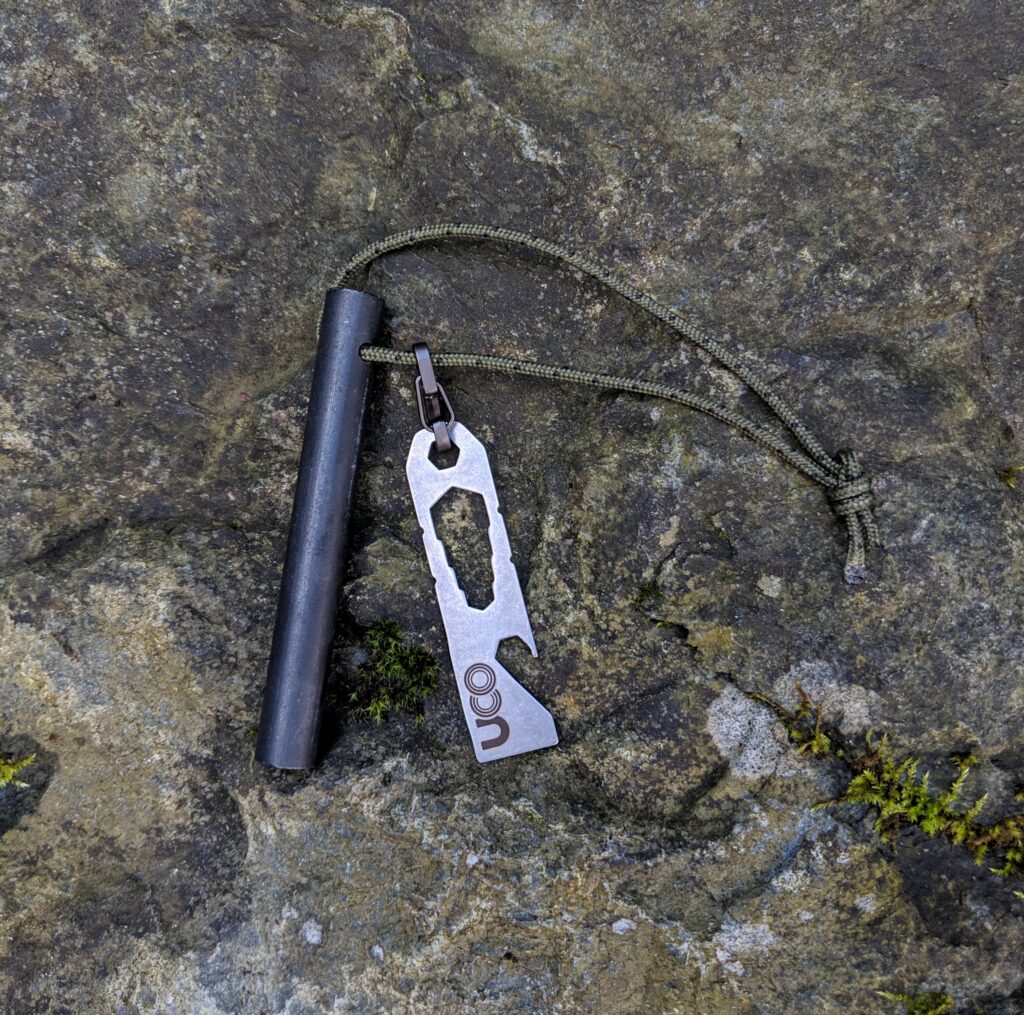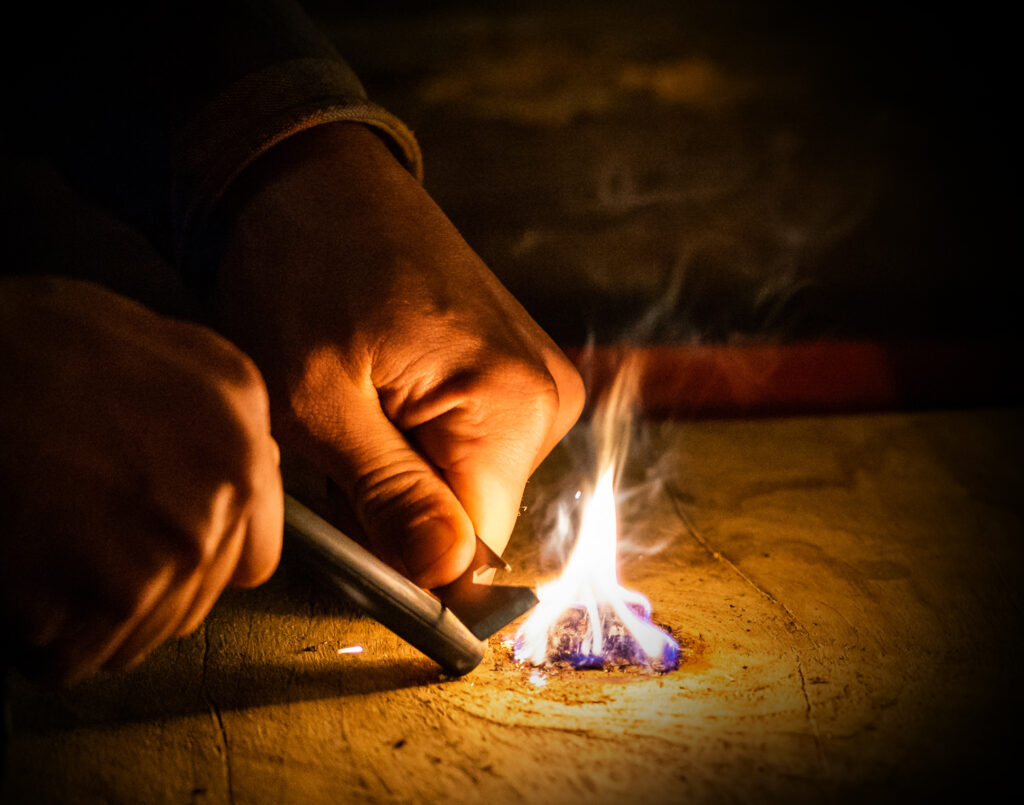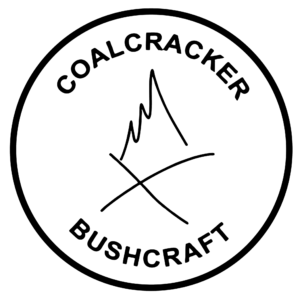
FIRE STARTING 101 – LESSON 4 – TIPS & TRICKS
As with anything, there are some tricks of the trade, and fire starting is no exception. Beyond material selection and the triangle of fire, there are a few, “outside the box”, tricks that anyone at any skill level can use.

Tip 1 – Set the Stage
Heat is a primary need for fire. Wet conditions, especially wet or damp ground, can drastically impact the influence heat has on the fuel. Likewise, wet conditions will also significantly affect the fuel. Wood quickly gathers moisture and it takes much more heat to dry out and ignite. With the environment affecting both heat and fuel, we need to do something to help ourselves. “Setting the stage” is a term I like to use when teaching students a way to combat wet ground.
There are two options: (1) Simply take a few pieces of fuel that you have gathered and laid them down in a row on the ground creating a small platform or (2) After gathering your fuel, split a few pieces of wood in half. This will expose the dry inner wood. Next, place the outer bark down facing the ground and the dry the inner part of the wood. This will give a dry stage to build a fire on, hence protecting it from the moisture.

Tip 2 – Scrape the Rod
When using a ferrocerium rod, there is actually a technique. Most people can get a fire from a spark on a dry day; however, the ferrocerium rod is an emergency device for all weather conditions. There are two techniques that provide maximum benefit with this fire starter. The first technique is termed the push-pull method. This method requires the user to drive their striker across the surface of the rod towards the tinder source while sequentially pulling the rod back.
These motions combined, remove a serious amount of material from the rod that results in a tremendous shower of sparks. The second technique is the pump method. This method requires the user to firmly plant the ferrocerium rod down onto their tinder source which basically pins down the tinder source. Then with much force, the user can pump their striker up and down the rod’s surface creating a shower of sparks. This method allows the user to overindulge the tinder source with a tremendous amount of heat in one specific area.


TITAN FIRE STRIKER – FERRO ROD – $14.99

Tip 3 – Use It If You Got It
Don’t just assume your ferrocerium rod is only for throwing hot sparks. The rod itself can be used to create fuel for the fire. With a smooth slow stroke of the ferro rod, you can easily remove shaving from it without igniting the shavings. By producing a generous amount of the shavings it allows us to optimize the heat during our initial fire attempt. Once a pile of shavings has been produced scrape your ferrocerium rod, this time throwing sparks, onto the pile of shavings and tinder. Now not only will the sparks you throw heat up the tinder but the shavings will ignite into a large glob of molten material.

Tip 4 – Duct Tape Will Fix It
Duct tape will fix anything, at least temporarily. This also goes for fixing the issue of not being able to start a fire. Duct Tape is made up of glue (accelerant) and a mesh of fibers (fuel). Duct Tape can be used effectively in fire starting. For this technique, the user needs to process the Duct Tape by pulling very thin slivers off of the tape. When these slivers are pulled from the tape, it creates more surface area and smaller fuel to accept the heat source. Each sliver that is torn exposes small hair-like fibers from the cross threads, these fibers are very beneficial – think of them as superfine tinder. Once the user creates a golf ball to baseball size of duct tape strips, the strips can be ignited with an open flame or ferrocerium rod. The tape will burn an extended amount of time which will allow the user time to fuel the fire.

Tip 5 – Don’t Go All In
Don’t get this confused with giving your absolute best effort when building a campfire. It is very important to collect a lot of the proper materials. The biggest concern that I see with people when they are creating a fire is that they don’t use enough tinder and kindling. If these elements are properly collected the ignition source reaps the benefits. Better preparation means more successful fire making. But overuse of ignition sources is something to avoid. Using a single match is better than using five and using part of a fire starter is better than using the whole thing. The only exception to this is that you don’t want to skimp out and fail at making a fire. Remember to use only enough ignition material that is needed. Going overboard is wasting resources that might be needed at a later time.

Tip 6 – Light it Up
Carrying a candle with your outdoor equipment can be a huge benefit. A candle can set the mood, provide light during the night, and also aid fire making. When dealing with damp materials we need a flame that can heat up and dry out those materials. Lighting a candle is fast and easy and gives us a long lasting flame to do just that task. We can keep the candle in our fire lay until our tinder is burning then remove it until later use. A candle can also be lit for the same purpose with a ferrocerium rod if no other ignition sources are available. Simply, create a pile of ferro rod shavings, like we talked about in Tip 3, and place the candle wick over the shavings. Once you ignite the shavings with your ferrocerium rod the heat will be intense enough to light that candle giving you instant fire!

Tip 7 – Practice
Like anything we do, practice makes perfect. Fire making is no exception. Spending time in the dirt, collecting materials, processing materials, building fire lays, and lighting ignition sources is very important. You need to practice in wet, dry, cold, and hot environments. Examine the triangle of fire (heat, oxygen and fuel) during each fire build. Try to evaluate why something is or is not working. This is the best way to gain more experience in fire creation. Most of all though, enjoy your time outdoors and make starting a fire just as much fun as everything else you are doing.
Hopefully this tips can help you in your future fire making efforts. No two fires are ever going to be the same. It is always important to have multiple tool in your fire making arsenal and use a combination of those tools in tough situations. Stay lit and stay in the woods!
About the Author
DAN WOWAK – APPALACHIAN BUSHMAN SCHOOL

Dan Wowak, Owner and Instructor, of Coalcracker Bushcraft and the Appalachian Bushman School, has been an avid outdoorsman since childhood. His love and passion for the outdoors began while fishing and hiking with his grandfather in the hills of Appalachia. Over the years, he continued pursuing his love for the outdoors through backpacking, camping, hunting, and trapping. As time went on, Dan’s enthusiasm for the outdoors compounded with his drive for reaching his physical and mental limits.
The collision of these two passions launched him into the unforgiving, highly dynamic world of survival and bushcraft. He spent years honing this craft and was driven to inspire individuals to pursue a love of wilderness skills. Dan has been formally teaching and sharing knowledge of survival and wilderness living for several years. Most recently Dan has had the opportunity to put his lifetime of knowledge and foundational survival approach to the test on History Channel’s Alone Television Series.

